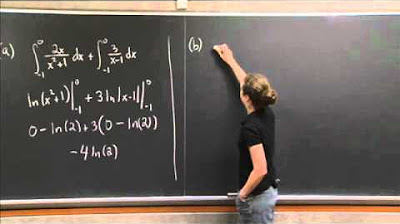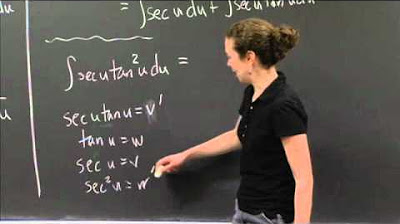Integration Practice IV | MIT 18.01SC Single Variable Calculus, Fall 2010
TLDRThis video script guides viewers through solving two integral problems, emphasizing the application of integration techniques. The first problem involves a definite integral of a composition of functions, tackled with a simple substitution method, resulting in a straightforward calculation. The second problem, an indefinite integral of a more complex expression, requires integration by parts, differentiating the arctan function and simplifying the remaining integral using partial fraction decomposition. The script concludes with a reminder to check work by differentiating the final answer.
Takeaways
- 📚 The video script is a tutorial on solving integrals using various techniques.
- 🔍 The first problem involves a definite integral of the product of x and an exponential function.
- 📝 The second problem is an indefinite integral involving arctan(x) over x squared.
- 🔑 The first integral is tackled using a straightforward substitution method.
- 📉 The substitution for the first integral sets u equal to 1 - x squared, simplifying the expression.
- 📌 The bounds of integration change from x = 0 to 2, to u = 1 to -3.
- 🧩 After substitution, the integral becomes a simple exponential function to integrate.
- 📈 The result of the first integral is obtained by evaluating the exponential function at the new bounds.
- 🤔 The second integral is more complex and initially considered for a substitution involving arctan(x).
- 🔄 Integration by parts is chosen over substitution for the second integral due to the properties of arctan(x).
- 📚 Applying integration by parts simplifies the second integral into a rational function plus a simpler integral.
- 📐 Partial fraction decomposition is used to simplify the rational function part of the second integral.
- 📘 The final step involves integrating the decomposed rational function, resulting in a combination of logarithmic and arctan functions.
- 🔍 A check is suggested by taking the derivative of the final answer to ensure it matches the original integral.
- 📝 The process emphasizes the importance of methodically applying calculus techniques and verifying results.
Q & A
What are the two integral problems discussed in the script?
-The two integral problems discussed are: 1) the definite integral from 0 to 2 of x times e to the power of (1 - x squared) with respect to x, and 2) the indefinite integral of 2 arctan(x) divided by x squared with respect to x.
What technique is suggested for solving the first integral problem?
-The technique suggested for solving the first integral problem is straightforward substitution, setting u equal to 1 minus x squared.
How does the substitution for the first integral change the bounds of integration?
-The substitution changes the bounds of integration from 0 to 2 for x to 1 to -3 for u, corresponding to the values of u when x equals 0 and 2, respectively.
What is the result of the first integral after applying the substitution and evaluating?
-The result of the first integral is minus 1/2 times e to the power of -3 minus e to the power of 1, which can be rewritten as e to the power of -3/2 minus e.
Why is integration by parts considered for the second integral problem?
-Integration by parts is considered for the second integral problem because it involves a product of functions, and arctan(x) is a function that simplifies upon differentiation, behaving like a logarithm in the context of integration by parts.
What substitution is considered for the second integral to eliminate arctan(x)?
-The substitution considered to eliminate arctan(x) is u equals arctan(x), which leads to x equals tan(u).
What method is used to simplify the remaining integral after the first application of integration by parts?
-Partial fraction decomposition is used to simplify the remaining integral after the first application of integration by parts.
How many constants are there in the partial fraction decomposition for the second integral?
-There are three constants in the partial fraction decomposition for the second integral, corresponding to the degree of the denominator and the number of terms in the numerator.
What are the results of the partial fraction decomposition for the second integral?
-The results of the partial fraction decomposition are 1/x for the linear term and -x/(1 + x squared) for the quadratic term, with constants A = 1, B = -1, and C = 0.
What are the final results of the second integral after integrating the decomposed parts?
-The final results of the second integral are 2 arctan(x)/x plus 2 times the natural logarithm of the absolute value of x minus 1/2 times the natural logarithm of (1 + x squared), plus a constant of integration.
How can one verify the correctness of the final answer for the second integral?
-One can verify the correctness of the final answer by taking the derivative of the antiderivative and checking if it matches the original integrand.
Outlines
📚 Introduction to Integration Techniques
The video script begins with an introduction to the topic of integration, highlighting that the viewer has learned various integration techniques in previous lectures. The instructor presents two integral problems: a definite integral involving the product of x and an exponential function, and an indefinite integral involving arctan(x) over x squared. The instructor encourages the viewer to attempt these problems before continuing with the video to solve them together.
🔍 Solving the Definite Integral Using Substitution
In this paragraph, the focus is on solving the first integral problem through the method of substitution. The integral is transformed by setting u to 1 minus x squared, which leads to a new integral in terms of u. The bounds of integration are adjusted accordingly, and the integral simplifies to an exponential function multiplied by a constant. The final step involves evaluating the exponential function at the new bounds and subtracting the results to find the definite integral's value.
🧩 Tackling the Indefinite Integral with Integration by Parts
The third paragraph delves into the process of solving the second integral problem using integration by parts. The instructor chooses to differentiate the arctan(x) term while integrating the 1/x^2 term, resulting in a simpler expression. After applying integration by parts, the remaining integral is a rational function that can be further simplified. The instructor considers different methods to tackle the resulting expression, such as trigonometric substitution or partial fraction decomposition, before deciding on the latter.
📐 Completing the Indefinite Integral with Partial Fractions
In the final paragraph, the instructor completes the solution to the second integral problem by applying partial fraction decomposition to the rational function obtained after integration by parts. The decomposition is straightforward due to the simple form of the denominator. The constants in the partial fraction are determined using the cover-up method and algebraic manipulation. The resulting expression is then integrated term by term, yielding a final antiderivative involving logarithmic and arctan functions. The instructor reminds the viewer to add a constant of integration at the end and suggests checking the work by differentiating the result to ensure it matches the original integral.
Mindmap
Keywords
💡Integration Techniques
💡Definite Integral
💡Indefinite Integral
💡Substitution
💡Chain Rule
💡Integration by Parts
💡Arctan
💡Partial Fractions
💡Trigonometric Functions
💡Product Rule
💡Fundamental Theorem of Calculus
Highlights
Introduction to the lecture on integration techniques with a problem-solving approach.
Presentation of the first definite integral problem involving x times e to the power of (1 - x squared).
Introduction of the second indefinite integral problem with 2 arctan(x) divided by x squared.
Suggestion to pause the video for self-practice before continuing with the solutions.
Explanation of the straightforward substitution technique for the first integral.
Identification of the composition of functions in the integral as a hint for the chain rule.
Substitution of u = 1 - x squared to simplify the integral.
Calculation of the differential du and the bounds of integration for u.
Transformation of the integral into a simpler form using the substitution method.
Application of the fundamental theorem of calculus to find the antiderivative of e to the u.
Direct evaluation of the definite integral without reverting to the original variable.
Introduction of the second problem's solution with a focus on the complexity of the expression.
Discussion of the potential substitution u = arctan(x) to simplify the integral.
Proposal of integration by parts as an alternative method to tackle the second integral.
Use of integration by parts to differentiate arctan(x) and simplify the integral.
Application of partial fraction decomposition to the resulting rational function from integration by parts.
Solution of constants A, B, and C in the partial fraction decomposition.
Integration of the decomposed rational function to find the antiderivative.
Final expression of the antiderivative with a constant of integration.
Recommendation to check the solution by differentiating the antiderivative to ensure correctness.
Transcripts
Browse More Related Video

Integration Practice I | MIT 18.01SC Single Variable Calculus, Fall 2010

Integration Practice III | MIT 18.01SC Single Variable Calculus, Fall 2010

Integration using completing the square and the derivative of arctan(x) | Khan Academy

Integration Practice II | MIT 18.01SC Single Variable Calculus, Fall 2010

Integration Of Exponential Functions [ Substitution Method ]

Calculus 2 Final Exam Review -
5.0 / 5 (0 votes)
Thanks for rating: